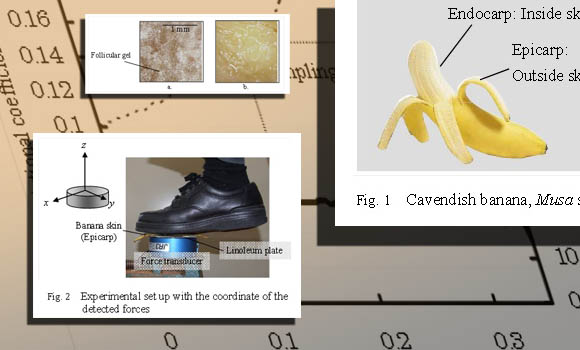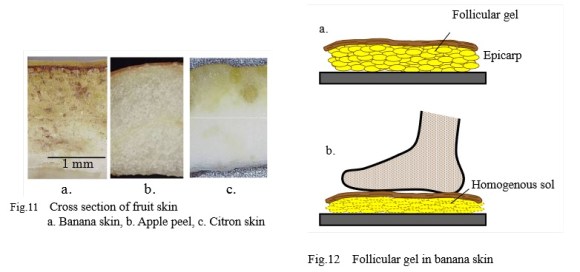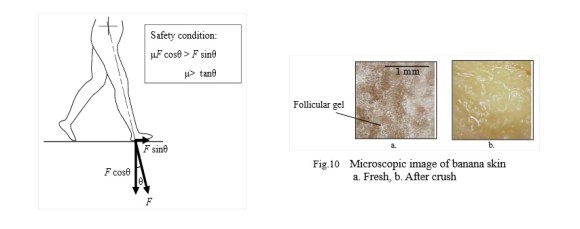
They feature so prominently in our Saturday morning cartoons and Charlie Chaplin movies that mankind has simply taken it as gospel that stepping on a banana peel will cause you to comically slip and fall with such a force that birds and stars will circle your head.
But did you know that until recently this was only a theory, unproven by a peer-reviewed scientific study? Thanks to the hard work done by Kiyoshi Mabuchi and his team at Kitasato University who were able to apply a frictional coefficient, we can unequivocally say that banana peels really are slippery when you step on them. Little wonder the group was awarded the 2014 Ig Nobel Prize in Physics.
At a ceremony held at Harvard University, Professor Mabuchi was present to accept his award, marking the eighth consecutive year that Japan was awarded an Ig Nobel Prize. When interviewed Professor Mabuchi said: “Banana peels being easy to slip on has been a self-evident thing, but I was able to scientifically prove it.”
The mechanics behind the banana peel’s legendary slipperiness are in tiny follicles on the inside skin. These little bubbles contain a gel-like substance that under normal circumstances isn’t terribly slippery. However, when pressure is applied, say from the foot of Wile E. Coyote, the membranes on these tiny follicles rupture and cause the gel to leak out and merge together creating a highly slick substance.
After examining the performance of this substance on various types of common flooring material, it was determined that a banana peel when stepped on with the inner side facing down will have a coefficient of friction (COF) of about 0.07, somewhere between a ski on snow and lubricated metal on metal. Although this information is useful in validating decades of comedic bits, Prof. Mabuchi is interested in the substance’s value as a potential lubricant for artificial limb joints.
So we salute the achievements of the team at Kitasato University and hope that some other research body in Japan can determine once and for all whether not realizing that you have just walked off the edge of a cliff will allow you to stay in the air.
Source: Improbable Research (English), Jijicom via Hachima Kiko (Japanese)
Professor Mabuchi and team’s report
Other Ig Nobel Prize winners for 2014
Neuroscience Prize
China/Canada
Jiangang Liu, Jun Li, Lu Feng, Ling Li, Jie Tian, and Kang Lee
For studying what happens in people’s brains when they see Jesus in a piece of toast
Psychology Prize
Australia/UK/USA
Peter K. Jonason, Amy Jones, and Minna Lyons
For building a case that people who stay up late are on average worse people than those who regularly wake up early in the morning
Public Health Prize
Czech Rep./Japan/USA/India
Jaroslav Flegr, Jan Havlíček, Jitka Hanušova-Lindova, David Hanauer, Naren Ramakrishnan and Lisa Seyfried
For looking into the potential dangers owning a cat might have on one’s mental health
Biology Prize
Czech Rep./Germany/Zambia
Vlastimil Hart, Petra Nováková, Erich Pascal Malkemper, Sabine Begall, Vladimír Hanzal, Miloš Ježek, Tomáš Kušta, Veronika Němcová, Jana Adámková, Kateřina Benediktová, Jaroslav Červený and Hynek Burda
For observing dogs’ preference to be aligned with Earth’s geomagnetic field when pooping or peeing
Art Prize
Italy
Marina de Tommaso, Michele Sardaro, and Paolo Livrea
For measuring the difference in pain sensitivity one has when being hit by a powerful laser and when looking at either a pretty or ugly painting
Economics Prize
Italy
National Institute of Statistics
For increasing the size of the national economy by including illegal business transactions between willing parties like prostitution or smuggling
Medicine Prize
USA/India
Ian Humphreys, Sonal Saraiya, Walter Belenky and James Dworkin
For treating nosebleeds by stuffing some cured pork up there
Arctic Science Award
Norway/Germany
Eigil Reimers and Sindre Eftestøl
For investigating how reindeer react to people dressed as polar bears
Nutrition Prize
Spain
Raquel Rubio, Anna Jofré, Belén Martín, Teresa Aymerich, and Margarita Garriga
For studying a method to ferment sausages using lactic acid bacteria from infant poop
Congratulations to all the winners!



 Osaka doctor wins Ig Nobel Prize for discovering kisses can reduce allergic reactions
Osaka doctor wins Ig Nobel Prize for discovering kisses can reduce allergic reactions Japanese doctor wins Ig Nobel Prize for learning we can kind of breathe in through our butts
Japanese doctor wins Ig Nobel Prize for learning we can kind of breathe in through our butts Painting a cow like a zebra keeps away pests according to Ig-Nobel-winning Japanese research
Painting a cow like a zebra keeps away pests according to Ig-Nobel-winning Japanese research Japanese news agency under fire for announcing Nobel Prize goes “to foreigners”
Japanese news agency under fire for announcing Nobel Prize goes “to foreigners” Japanese constitution nominated for Nobel Peace Prize
Japanese constitution nominated for Nobel Peace Prize Hayao Miyazaki says Happy New Year to Studio Ghibli fans with new art for Year of the Horse
Hayao Miyazaki says Happy New Year to Studio Ghibli fans with new art for Year of the Horse We revisited Sweets Paradise after a decade to see if Japan’s dessert buffet still delivers
We revisited Sweets Paradise after a decade to see if Japan’s dessert buffet still delivers Pizza Hut Japan’s hot lucky bags are perfect for a New Year’s pizza party
Pizza Hut Japan’s hot lucky bags are perfect for a New Year’s pizza party Dragon Quest Burgers and Slime drinks are coming to McDonald’s Japan【Video】
Dragon Quest Burgers and Slime drinks are coming to McDonald’s Japan【Video】 Otaku woman in Japan finds herself target of strange fake shoplifting scam, netizens urge caution
Otaku woman in Japan finds herself target of strange fake shoplifting scam, netizens urge caution Curry chain CoCo Ichi opens branch in Japan serving Japanese curry rice created outside Japan
Curry chain CoCo Ichi opens branch in Japan serving Japanese curry rice created outside Japan Owner of ridiculously long tongue is also a former idol, does cool tongue tricks
Owner of ridiculously long tongue is also a former idol, does cool tongue tricks Tiny storage container hotels become the latest craze in Japan, thanks to Hotel R9 The Yard
Tiny storage container hotels become the latest craze in Japan, thanks to Hotel R9 The Yard How to speak Japanese like a gyaru【2024 edition】
How to speak Japanese like a gyaru【2024 edition】 We take a ride on Seibu Railway’s futuristic luxury liner: the Limited Express Laview
We take a ride on Seibu Railway’s futuristic luxury liner: the Limited Express Laview Starbucks Japan ready to get Year of the Horse started with adorable drinkware and plushies【Pics】
Starbucks Japan ready to get Year of the Horse started with adorable drinkware and plushies【Pics】 Cyberpunk anime meets traditional culture in Ghost in the Shell gold leaf Japanese changing screens
Cyberpunk anime meets traditional culture in Ghost in the Shell gold leaf Japanese changing screens 7 great places to see Mt. Fuji from without having to climb it
7 great places to see Mt. Fuji from without having to climb it Hello Kitty Choco Egg figures are an adorable trip through three periods of Japanese pop culture【Pics】
Hello Kitty Choco Egg figures are an adorable trip through three periods of Japanese pop culture【Pics】 7-Eleven Japan’s ramen-cooking robot whipped us up a bowl of noodles【Taste test】
7-Eleven Japan’s ramen-cooking robot whipped us up a bowl of noodles【Taste test】 We found possibly the quietest Japanese-style hotel in Tokyo’s bustling Shinjuku district
We found possibly the quietest Japanese-style hotel in Tokyo’s bustling Shinjuku district Japan’s otoshidama tradition of giving kids money at New Year’s gets a social welfare upgrade
Japan’s otoshidama tradition of giving kids money at New Year’s gets a social welfare upgrade Sumo Sanrio! Hello Kitty and pals team up with Japan Sumo Association for new merch【Pics】
Sumo Sanrio! Hello Kitty and pals team up with Japan Sumo Association for new merch【Pics】 More Than a Capsule Stay: Why Solo Travelers Choose “global cabin Yokohama Chinatown”
More Than a Capsule Stay: Why Solo Travelers Choose “global cabin Yokohama Chinatown” Japan’s oldest largetooth sawfish in captivity back on display in Mie Prefecture
Japan’s oldest largetooth sawfish in captivity back on display in Mie Prefecture 7-Eleven Japan starts new temporary luggage storage service in over 300 branches
7-Eleven Japan starts new temporary luggage storage service in over 300 branches Disillusionment at Tsukiji’s tourist-target prices led us to a great ramen restaurant in Tokyo
Disillusionment at Tsukiji’s tourist-target prices led us to a great ramen restaurant in Tokyo Starbucks teams up with 166-year-old Kyoto doll maker for Year of the Horse decorations【Photos】
Starbucks teams up with 166-year-old Kyoto doll maker for Year of the Horse decorations【Photos】 Tokyo considering law requiring more trash cans following litter increase in heavily touristed area
Tokyo considering law requiring more trash cans following litter increase in heavily touristed area Tokyo’s Tsukiji sushi neighborhood asks tour groups to stay away for the rest of the month
Tokyo’s Tsukiji sushi neighborhood asks tour groups to stay away for the rest of the month Tokyo event lets you travel back in time, for free, to celebrate 100 years since Showa era start
Tokyo event lets you travel back in time, for free, to celebrate 100 years since Showa era start Sanrio theme park in Japan announces plans to expand into a Sanrio resort
Sanrio theme park in Japan announces plans to expand into a Sanrio resort Japan may add Japanese language proficiency, lifestyle classes to permanent foreign resident requirements
Japan may add Japanese language proficiency, lifestyle classes to permanent foreign resident requirements Stamina-destroying “Paralysis Noodles” are Tokyo’s newest over-the-top ramen innovation
Stamina-destroying “Paralysis Noodles” are Tokyo’s newest over-the-top ramen innovation Survey asks foreign tourists what bothered them in Japan, more than half gave same answer
Survey asks foreign tourists what bothered them in Japan, more than half gave same answer Japan’s human washing machines will go on sale to general public, demos to be held in Tokyo
Japan’s human washing machines will go on sale to general public, demos to be held in Tokyo Japan’s deadliest food claims more victims, but why do people keep eating it for New Year’s?
Japan’s deadliest food claims more victims, but why do people keep eating it for New Year’s? We deeply regret going into this tunnel on our walk in the mountains of Japan
We deeply regret going into this tunnel on our walk in the mountains of Japan Studio Ghibli releases Kodama forest spirits from Princess Mononoke to light up your home
Studio Ghibli releases Kodama forest spirits from Princess Mononoke to light up your home Major Japanese hotel chain says reservations via overseas booking sites may not be valid
Major Japanese hotel chain says reservations via overseas booking sites may not be valid Put sesame oil in your coffee? Japanese maker says it’s the best way to start your day【Taste test】
Put sesame oil in your coffee? Japanese maker says it’s the best way to start your day【Taste test】 No more using real katana for tourism activities, Japan’s National Police Agency says
No more using real katana for tourism activities, Japan’s National Police Agency says Starbucks Japan reveals new sakura drinkware collection, inspired by evening cherry blossoms
Starbucks Japan reveals new sakura drinkware collection, inspired by evening cherry blossoms Updated cherry blossom forecast shows extra-long sakura season for Japan this year
Updated cherry blossom forecast shows extra-long sakura season for Japan this year Zimbabwe President Robert Mugabe wins China’s Confucius Peace Prize
Zimbabwe President Robert Mugabe wins China’s Confucius Peace Prize Nobel Prize-winner Shuji Nakamura to Japan’s young people: “Get out of Japan”
Nobel Prize-winner Shuji Nakamura to Japan’s young people: “Get out of Japan” Japanese Cabinet to Reward Nobel Prize Winner with New Washing Machine
Japanese Cabinet to Reward Nobel Prize Winner with New Washing Machine
Leave a Reply